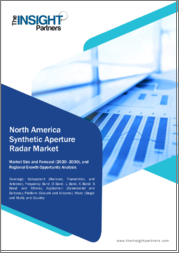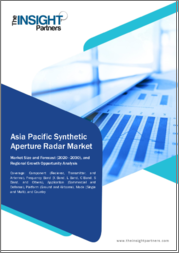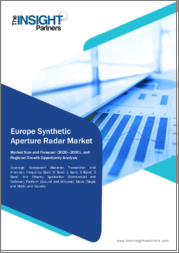
|
시장보고서
상품코드
1622781
세계의 합성 개구 레이더 시장 규모 : 제품별, 용도별, 지역별, 범위 및 예측Global Synthetic Aperture Radar Market Size By Product (Airborne, Ground), By Application (Defense, Commercial), By Geographic Scope And Forecast |
||||||
합성 개구 레이더 시장 규모 및 전망
합성 개구 레이더 시장 규모는 2020년 32억 7,000만 달러, 2028년에는 82억 2,000만 달러에 달할 것으로 예상되며, 2021년부터 2028년까지 연평균 14.04% 성장할 것으로 예상됩니다.
위성 및 레이더 이미징 기술의 발전은 세계 합성 조리개 레이더 시장의 수익 성장에 영향을 미치고 있습니다. 이 조사 보고서는 세계 합성 조리개 레이더 시장을 종합적으로 평가합니다. 주요 부문, 동향, 시장 촉진요인, 경쟁 환경, 시장에서 중요한 역할을 하는 요인 등을 포괄적으로 분석합니다.
합성 개구 레이더 세계 시장 정의
합성 개구 레이더(SAR)는 풍경이나 구성요소의 2차원 또는 3차원 재현을 생성하는 데 사용됩니다. 합성 조리개 레이더는 고해상도 원거리 감각 이미지를 생성하는 우주 레이더 또는 공중 레이더 기술입니다. 이 시스템은 비행 경로에서 수집하고 개구부와 대형 안테나를 디지털 방식으로 강화합니다. 합성 조리개는 위상 배열 레이더와 유사한 기능을 가지고 있으며, SAR 장비는 지구를 향해 에너지를 생성하고 그 에너지가 지표면에 닿은 후 어떻게 분산되는지 측정 할 수 있기 때문에 에너지 센서입니다.
합성 개구 레이더는 수많은 병렬 안테나 대신 특정 안테나를 시간 다중으로 활용합니다. 여러 지역에서 데이터를 수집하여 종합적인 이동 플랫폼을 실현합니다. 전 세계 합성 개구 레이더는 크게 공중형과 지상형으로 나뉩니다. 무인항공기(UAV)에 탑재된 공중 합성 개구 레이더는 활기찬 지형뿐만 아니라 눈 덮인 경사면 등 변화무쌍한 지형에서도 데이터 수집을 용이하게 합니다. 합성 개구 레이더는 미사일 방어, 지구 자원 매핑, 환경 감지 등에 사용됩니다. 지진이나 싱크홀이 생긴 후 자연 및 인위적 교란의 영향을 조사합니다.
합성 개구 레이더 세계 시장 개요
합성 개구 레이더 우주 탐사선과 컨스텔레이션은 여러 방향과 카메라 각도에서 이미지를 캡처합니다. 이는 또한 더 적은 수의 위성 시스템으로 더 일반적인 목적의 이미징이 가능하다는 것을 의미합니다. 합성 조리개 레이더 위성의 사용은 상세한 이미지와 자동차와 같은 작은 물체의 인식으로 구성됩니다. 또한, 합성 개구 레이더는 지형 특징과 표면 질감을 3차원으로 정확하게 식별할 수 있습니다. 위성 및 레이더 이미징 기술의 개발은 세계 합성 조리개 레이더 시장의 수익 성장에 영향을 미치고 있습니다.
또한, 합성 개구 레이더는 지표면 데이터를 얻기 위해 햇빛이 필요하지 않기 때문에 합성 개구 레이더 위성은 낮에도 밤에도 충분한 성과를 거둘 수 있습니다. 합성 개구 레이더 시스템의 비용 증가가 전체 성장을 제한하는 요인으로 작용할 수 있습니다. 합성 개구 레이더 시스템은 필연적으로 고감도 부품을 설치해야 하기 때문에 이러한 위성의 발전은 기존 위성보다 훨씬 더 비쌉니다.
또한, 혁신적인 원격 센서와 레이더 모듈의 사용은 합성 조리개 레이더 시스템의 운영 비용을 증가시켜 전반적인 성장에 부정적인 영향을 미칩니다. 다중 채널 SAR 시스템의 발전은보다 지능적인 모니터링 기술의 개발을 촉진했습니다. 모든 기상 조건에서 SAR 장비는 광범위한 감시를 위한 우수한 데이터를 제공합니다. 이 장비는 선박, 기름 유출, 김 시설, 감시, 우주, 광업, 해양 석유 탐사 등 해양 표면을 신속하게 시각화하는 데 널리 사용되고 있습니다.
목차
제1장 합성 개구 레이더 세계 시장 : 소개
- 시장 개요
- 조사 범위
- 가정
제2장 주요 요약
제3장 VERIFIED MARKET RESEARCH 조사 방법
- 데이터 마이닝
- 밸리데이션
- 1차 자료
- 데이터 소스 리스트
제4장 합성 개구 레이더 세계 시장 전망
- 개요
- 시장 역학
- 성장 촉진요인
- 성장 억제요인
- 기회
- Porter's Five Forces 모델
- 밸류체인 분석
제5장 합성 개구 레이더 세계 시장 : 제품별
- 개요
- 항공기용
- 지상
제6장 합성 개구 레이더 세계 시장 : 용도별
- 개요
- 상업
- 방위
제7장 합성 개구 레이더 세계 시장 : 지역별
- 개요
- 북미
- 미국
- 캐나다
- 멕시코
- 유럽
- 독일
- 영국
- 프랑스
- 기타 유럽
- 아시아태평양
- 중국
- 일본
- 인도
- 기타 아시아태평양
- 세계 기타 지역
- 라틴아메리카
- 중동 및 아프리카
제8장 합성 개구 레이더 세계 시장 : 경쟁 구도
- 개요
- 각사의 시장 순위
- 주요 개발 전략
제9장 기업 개요
- Lockheed Martin
- Thales
- Cobham
- Israel Aerospace
- Leonardo
- Saab AB
- GA-ASI
- BAE Systems
제10장 주요 발전
- 제품 출시/개발
- 인수합병
- 사업 확대
- 파트너십과 제휴
제11장 부록
- 관련 조사
Synthetic Aperture Radar Market Size And Forecast
Synthetic Aperture Radar Market size was valued at USD 3.27 Billion in 2020 and is projected to reachUSD 8.22 Billion by 2028
, growing at aCAGR of 14.04% from 2021 to 2028.
Developments in satellite and radar imaging technologies are influencing revenue growth in the global Synthetic Aperture Radar Market. The Global Synthetic Aperture Radar Market report provides a holistic evaluation of the market. The report offers a comprehensive analysis of key segments, trends, drivers, restraints, competitive landscape, and factors that are playing a substantial role in the market.
Global Synthetic Aperture Radar Market Definition
Synthetic aperture radar, or SAR, is being used to create two-dimensional or three-dimensional recreations of a landscape or a component. It is most frequently a space-borne or airborne radar technology that produces high-resolution distant sensory images. This system collects from the flight path to digitally enhance an aperture or big antenna. Synthetic aperture functions similarly to phased array radar. SAR instruments are energetic sensors since they can generate energy toward the Earth and then measure how that energy is dispersed once it comes into contact with the Earth's surface.
Synthetic aperture radar utilizes a specific antenna in time multiplexing instead of a huge number of parallel antennas. It gathers data from multiple geographic regions, resulting in a comprehensive moving platform. The Global Synthetic Aperture Radar is classified as Airborne and Ground. Airborne synthetic aperture radars in unmanned aerial vehicles (UAVs) allow for easy data gathering in fast-changing types of terrain including such snow slopes as well as active terrain. Synthetic aperture radar is used in missile defenses for earth resource mapping, environmental sensing, and other considerations Examine the effects of natural and man disruptions following earthquakes or sinkhole openings.
Global Synthetic Aperture Radar Market Overview
Synthetic aperture radar space probes and constellations capture images from several different directions and camera angles. It also means allowing for more common imaging of objectives with fewer satellite systems. The use of synthetic aperture radar satellites consists of detailed images and the recognition of small objects such as automobiles. Moreover, synthetic aperture radar identifies topographic features and surface texture in three dimensions with high precision. Developments in satellite and radar imaging technologies are influencing revenue growth in the global Synthetic Aperture Radar Market.
Furthermore, Synthetic aperture radar does not require sunlight to obtain surface data, enabling synthetic aperture radar satellites to accomplish well both during the day and at night. The increased cost of synthetic aperture radar systems probably limits overall growth. Because synthetic aperture radar systems necessarily require the installation of sensitive components, the advancement of these satellites is much more expensive than those of conventional satellites.
Furthermore, the use of innovative remote sensors and radar modules increases the operational costs of synthetic aperture radar systems, negatively affecting overall growth. The advancement of multi-channel SAR systems facilitated the development of more intelligent monitoring techniques. Under all meteorological conditions, the SAR instrument offers superior data for wide-area surveillance. These devices are extensively have been used to visualize oceanic surfaces rapidly for vessels, oil spills, laver facilities, monitoring, space, mining, and offshore oil exploration, among many other things.
Global Synthetic Aperture Radar Market Segmentation Analysis
The Global Synthetic Aperture Radar Market is Segmented on the basis of Product, Application, And Geography.
Synthetic Aperture Radar Market, By Product
- Airborne
- Ground
Based on Product, the market is segmented into Airborne and Ground. Airborne has the highest-growing segment of the global Synthetic Aperture Radar Market. Producers of airborne synthetic aperture radars are planning to implement highly specialized airborne synthetic aperture radars for Unmanned Aerial Vehicles (UAVs), as to use of airborne synthetic aperture radars in UAVs provides convenient data gathering in rapidly terrains including such snow slopes and volcanoes.
Synthetic Aperture Radar Market, By Application
- Defense
- Commercial
Based on Application, the market is segmented into Defense and Commercial. The Defense has the largest growing segment of the global Synthetic Aperture Radar Market. SAR is increasingly being used in monitoring, intelligence gathering, and trying to target applications. Defense agencies across the world are granting contracts to industry players to supply high-resolution radars with geographic information systems intelligence during the forecasted period.
Synthetic Aperture Radar Market, By Geography
- North America
- Europe
- Asia-Pacific
- Rest of the World
Based on Geography, the Global Synthetic Aperture Radar Market is segmented into North America, Europe, Asia-Pacific, and the Rest of the world. North America is projected to be the highest-growing market over the forecasted period. The existence of SAR manufacturing and service suppliers such as Lockheed Martin and Capella Space is enhancing regional market demand. Government policies that stimulate the growth of space-based electronics have a productive influence on market statistical data.
Key Players
- The "Global Synthetic Aperture Radar Market" study report will provide valuable insight with an emphasis on the global market. The major players in the market are
- Lockheed Martin, Thales, Cobham, Israel Aerospace, Leonardo, Saab AB, GA-ASI, BAE Systems, and Aselsan.
Our market analysis also entails a section solely dedicated to such major players wherein our analysts provide insight to the financial statements of all the major players, along with product benchmarking and SWOT analysis. The competitive landscape section also includes key development strategies, market share, and market ranking analysis of the above-mentioned players globally.
Key Developments
- In November 2020, Advent International (Advent), a private equity firm located in the United States, has accomplished its acquisition of Cobham PLC for GBP 4 billion. Following a 93 percent vote in favor of the deal by its shareholders, the acquisition was authorized by regulators in the United Kingdom, the United States, France, Australia, and Finland. Following the contract, Cobham's shares were blacklisted from the London Stock Exchange.
- In September 2020, IMSAR and Primoco UAV effectively tested and the results the NSP-7 Synthetic Aperture Radar on the Primoco One 150 UAV. The aircraft's effectiveness was affirmed during live flight tests in the Czech Republic, which proved flight perseverance of up to ten hours. With the SAR radar placed on the port side of the fuselage, the payload bay remains free from obstruction, and the EO/IR surveillance system can be assembled and operated instantaneously.
TABLE OF CONTENTS
1 INTRODUCTION OF GLOBAL SYNTHETIC APERTURE RADAR MARKET
- 1.1 Overview of the Market
- 1.2 Scope of Report
- 1.3 Assumptions
2 EXECUTIVE SUMMARY
3 RESEARCH METHODOLOGY OF VERIFIED MARKET RESEARCH
- 3.1 Data Mining
- 3.2 Validation
- 3.3 Primary Interviews
- 3.4 List of Data Sources
4 GLOBAL SYNTHETIC RADAR APERTURE MARKET OUTLOOK
- 4.1 Overview
- 4.2 Market Dynamics
- 4.2.1 Drivers
- 4.2.2 Restraints
- 4.2.3 Opportunities
- 4.3 Porters Five Force Model
- 4.4 Value Chain Analysis
5 GLOBAL SYNTHETIC APERTURE RADAR MARKET, BY PRODUCT
- 5.1 Overview
- 5.2 Airborne
- 5.3 Ground
6 GLOBAL SYNTHETIC APERTURE RADAR MARKET, BY APPLICATION
- 6.1 Overview
- 6.2 Commercial
- 6.3 Defense
7 GLOBAL SYNTHETIC APERTURE RADAR MARKET, BY GEOGRAPHY
- 7.1 Overview
- 7.2 North America
- 7.2.1 U.S.
- 7.2.3 Canada
- 7.2.4 Mexico
- 7.3 Europe
- 7.3.1 Germany
- 7.3.2 U.K.
- 7.3.3 France
- 7.3.4 Rest of Europe
- 7.4 Asia Pacific
- 7.4.1 China
- 7.4.2 Japan
- 7.4.3 India
- 7.4.4Rest of Asia Pacific
- 7.5 Rest of the World
- 7.5.1 Latin America
- 7.5.2 Middle East and Africa
8 GLOBAL SYNTHETIC APERTURE RADAR MARKET COMPETITIVE LANDSCAPE
- 8.1 Overview
- 8.2 Company Market Ranking
- 8.3 Key Development Strategies
9 COMPANY PROFILES
- 9.1 Lockheed Martin
- 9.1.1 Overview
- 9.1.2 Financial Performance
- 9.1.3 Product Outlook
- 9.1.4 Key Developments
- 9.2 Thales
- 9.2.1 Overview
- 9.2.2 Financial Performance
- 9.2.3 Product Outlook
- 9.2.4 Key Developments
- 9.3 Cobham
- 9.3.1 Overview
- 9.3.2 Financial Performance
- 9.3.3 Product Outlook
- 9.3.4 Key Developments
- 9.4 Israel Aerospace
- 9.4.1 Overview
- 9.4.2 Financial Performance
- 9.4.3 Product Outlook
- 9.4.4 Key Developments
- 9.5 Leonardo
- 9.5.1 Overview
- 9.5.2 Financial Performance
- 9.5.3 Product Outlook
- 9.5.4 Key Developments
- 9.6 Saab AB
- 9.6.1 Overview
- 9.6.2 Financial Performance
- 9.6.3 Product Outlook
- 9.6.4 Key Developments
- 9.7 GA-ASI
- 9.7.1 Overview
- 9.7.2 Financial Performance
- 9.7.3 Product Outlook
- 9.7.4 Key Developments
- 9.8 BAE Systems
- 9.8.1 Overview
- 9.8.2 Financial Performance
- 9.8.3 Product Outlook
- 9.8.4 Key Developments
10 KEY DEVELOPMENTS
- 10.1 Product Launches/Developments
- 10.2 Mergers and Acquisitions
- 10.3 Business Expansions
- 10.4 Partnerships and Collaborations
11 Appendix
- 11.1 Related Research



















